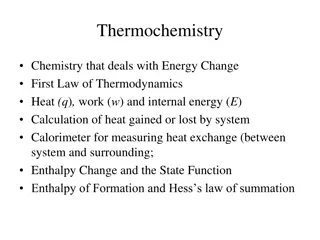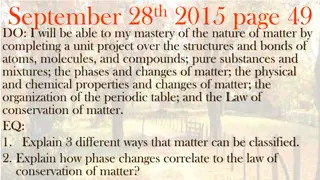Understanding Matter and Energy in Chemistry: A Comprehensive Overview
Exploring the intricate nature of matter, this collection delves into the fundamentals of chemistry, from the macroscopic to the particulate level. Covering topics such as the states of matter, kinetic nature, physical properties, and other states of matter like plasma and Bose-Einstein condensate, these insights provide a holistic view of how atoms and molecules shape our world.
Download Presentation

Please find below an Image/Link to download the presentation.
The content on the website is provided AS IS for your information and personal use only. It may not be sold, licensed, or shared on other websites without obtaining consent from the author. Download presentation by click this link. If you encounter any issues during the download, it is possible that the publisher has removed the file from their server.
E N D
Presentation Transcript
Matter And Energy Chemistry I: Chapter 2a SAVE PAPER AND INK!!! When you print out the notes on PowerPoint, print "Handouts" instead of "Slides" in the print setup. Also, turn off the backgrounds (Tools>Options>Print>UNcheck "Background Printing")! Chemistry I Honors: Chapter 2 ICP: Chapter 15 & 16a
The Nature of Matter Gold Mercury Chemists are interested in the nature of matter and how this is related to its atoms and molecules.
Chemistry & Matter We can explore the MACROSCOPIC world what we can see to understand the PARTICULATE worlds we cannot see. We write SYMBOLS to describe these worlds.
A Chemists View of Water Macroscopic H2O (gas, liquid, solid) Symbolic Particulate
A Chemists View Macroscopic 2 H2(g) + O2 (g) --> 2 H2O(g) Symbolic Particulate
Kinetic Nature of Matter Matter consists of atoms and molecules in _____.
STATES OF MATTER _______ have rigid shape, fixed volume. External shape can reflect the atomic and molecular arrangement. Reasonably well understood. _______ have no fixed shape and may not fill a container completely. Not well understood. _______ expand to fill their container. Good theoretical understanding.
OTHER STATES OF MATTER PLASMA an electrically charged gas; Example: the sun or any other star BOSE-EINSTEIN CONDENSATE a condensate that forms near absolute zero that has superconductive properties; Example: supercooled Rb gas
Physical Properties What are some physical properties? color melting and boiling point odor
Graphite layer structure of carbon atoms reflects physical properties.
Physical Changes can be observed without changing the identity of the substance Some physical changes would be boiling of a liquid melting of a solid dissolving a solid in a liquid to give a homogeneous mixture a SOLUTION.
Chemical Properties and Chemical Change Burning hydrogen (H2) in oxygen (O2) gives H2O. Chemical change or chemical reaction transformation of one or more atoms or molecules into one or more different molecules.
Sure Signs of a Chemical Change Heat Light Gas Produced (not from boiling!) Precipitate a solid formed by mixing two liquids together http://www.youtube.com/watch?v =DITY2rXYU-I
Physical vs. Chemical Examples: melting point physical flammable chemical density physical magnetic physical tarnishes in air chemical
Physical vs. Chemical Examples: rusting iron dissolving in water burning a log melting ice grinding spices
Matter Flowchart MATTER yes no Can it be physically separated? Can it be physically separated? MIXTURE PURE SUBSTANCE yes no yes no Is the composition uniform? Can it be chemically decomposed? Homogeneous Mixture (solution) Heterogeneous Mixture Compound Element Colloids Suspensions
Types of Mixtures Variable combination of 2 or more pure substances. Heterogeneous visibly separate phases Homogeneous Same throughout
Energy Mostly covered in physics Two types Kinetic Potential























